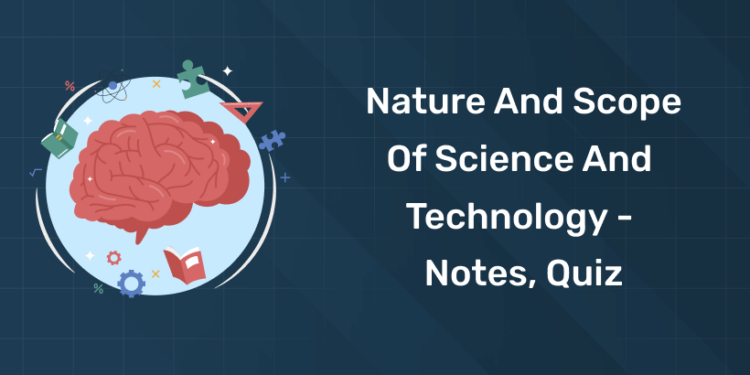Table of Contents
Science and technology are essential to the development of innovation, the shaping of our reality, and the advancement of humankind. Anybody interested in delving into the complexity of these subjects must have a thorough understanding of their nature and breadth. We’ll explore the essential ideas, tenets, and developments that characterise the ever-evolving field of science and technology in this blog. To help you learn more and assess your knowledge, we’ll also give you thorough notes and a PDF quiz in nature and scope of science and technology.
Nature and Scope of Science and Technology Summary
Science is a methodical technique that uses analysis, experimentation, and observation to help us comprehend the natural world. It makes use of empirical data to explain occurrences, identify trends, and formulate predictions. On the other side, technology is the use of scientific concepts and knowledge to address real-world issues and enhance human existence.
Scope of Science:
Science is a broad field that includes many different fields such as physics, chemistry, biology, astronomy, and earth sciences. From the smallest particles to the vastness of the universe, these disciplines investigate many facets of the natural world. In order to solve complicated problems, interdisciplinary domains in science—such as environmental science, biotechnology, and materials science—integrate knowledge from several disciplines.
The methods, strategies, and equipment that scientists employ to carry out research and study the natural world are also included in the scope of science. The application of scientific concepts and information in other domains, such as technology, engineering, medicine, agriculture, and other areas, is another aspect of science. In conclusion, the breadth of scientific study and its influence on our comprehension of the surrounding environment are all included in the scope of science.
Natural sciences:
This covers academic fields like astronomy, geology, biology, chemistry, and physics. These fields of study examine occurrences in the physical and natural world, ranging from the tiniest particles to the biggest cosmic structures.
Social sciences:
This covers academic fields like economics, political science, anthropology, psychology, and sociology. These fields of study aim to comprehend how organisations, societies, and human behaviour work and change throughout time.
Applied sciences:
This covers fields including environmental science, engineering, medicine, and agriculture. These fields use scientific methods and ideas to solve real-world issues and enhance people’s quality of life.
Interdisciplinary sciences:
This covers disciplines including environmental science, bioinformatics, and neurology. These sciences combine several academic fields to investigate intricate occurrences and create fresh methods for conducting scientific inquiry.
Basic research:
This kind of research aims to increase our basic understanding of the natural world without necessarily having any direct applications in the real world. In addition to being crucial for expanding our knowledge of the world, basic research frequently yields surprising findings and innovations.
Scope of Technology:
Technology is a broad category that includes many different instruments, methods, and procedures created to satisfy human needs and increase efficiency. Technology has impacted every facet of human existence, from early breakthroughs like the printing press and wheel to more recent ones like cellphones and artificial intelligence. Technology is a major force behind economic growth and societal advancement in a variety of industries, including manufacturing, communications, transportation, healthcare, and agriculture.
Importance of Science and Technology
Science and technology are integral to almost every facet of our lives in the linked and fast changing world of today. The importance of science and technology cannot be emphasised, from improvements in healthcare to breakthroughs in communication. We’ll examine how science and technology are important and relevant in today’s world, as well as how they advance society, address problems, and improve human welfare.
Advancing Healthcare:
Medical treatments, diagnostics, and illness prevention have all improved as a result of the scientific and technological revolution in healthcare. The use of vaccines, antibiotics, sophisticated imaging methods, and personalised therapy has greatly increased life expectancy and improved patient outcomes.
Driving Economic Growth:
Technology and science promote innovation, productivity, and competitiveness, which in turn propel economic growth. Technological developments fueled by research and development propel new sectors, generate employment, and boost economic activity, all of which contribute to general prosperity and growth.
Enhancing Communication:
The way we connect and communicate with one other has changed as a result of technological developments in communication. These technologies, which span geographic and cultural boundaries, have improved accessibility, efficiency, and inclusivity of communication. Examples of these technologies include social media, cellphones, high-speed internet, and video conferencing.
Solving Global Challenges:
In order to solve urgent global issues like infectious illnesses, food insecurity, and climate change, science and technology are essential. Scientists and engineers work together to create sustainable solutions that advance public health, food security, and environmental stewardship via research, innovation, and teamwork.
Empowering Education:
Science and technology are essential to education because they give teachers and students access to knowledge, materials, and teaching aids. Digital libraries, interactive simulations, and online learning platforms facilitate lifelong learning and give people the ability to learn new things.
Fostering Innovation:
By expanding the realm of possibility and questioning accepted wisdom, science and technology spur innovation. Scientists and engineers produce new technology, goods, and services that meet unmet needs and bring value to society through study and testing.
Improving Quality of Life:
The ability of science and technology to raise the standard of living for people and communities worldwide is ultimately what makes them relevant. Science and technology contribute to human well-being and society progression through changes in healthcare, environmental sustainability, and economic prosperity, among other areas.
History of Science and Technology
Science is, at its most basic, the study of the natural world. Since Homo sapiens first appeared as a species, humanity has had to learn to survive by recognising a great deal of natural regularities. Periodically, the motions of the Sun and the Moon are repeated. Certain motions are easy to see, such as the Sun’s daily “motion,” but others, such as the Sun’s annual “motion,” are much more challenging. Significant occurrences on Earth are correlated with both movements.
Human existence is governed by the basic rhythm of day and night. The animal movement that has been essential to human life for millennia is determined by the changing of the seasons. The seasons became much more important after agriculture was developed because planting at the incorrect time could result in hunger. Science, which is basically the understanding of natural processes, has existed since the beginning of human history and is shared by all people.
Key Concepts in Science and Technology:
- Understanding fundamental ideas like the scientific method, natural laws, technological innovation, and ethical considerations is crucial to comprehending the nature and use of science and technology.
- These ideas serve as the cornerstone for scientific investigation and the advancement of technology, directing scientists and engineers in their pursuit of understanding and creativity.
Nature and Scope of Science and Technology Quiz
We have put up in-depth notes on the nature and use of science and technology to support your educational journey. These notes address key ideas, historical turning points, and contemporary developments in science and technology. In addition, a PDF quiz has been developed by us to assess your comprehension of the subject matter. These tools are intended to enhance your investigation of science and technology, regardless of your learning style—student, teacher, or inquisitive learner.
Nature and Scope of Science and Technology Quiz – Free PDF
Q1. Which telescope was recently launched to examine early galaxies?
(a) James Webb Space Telescope
(b) Hubble Space Telescope
(c) Kepler Space Telescope
(d) Spitzer Space Telescope
Answer: (a) James Webb Space Telescope
Q2. What kind of molecule can be edited in living things using the CRISPR-Cas9 tool?
(a) Carbohydrates
(b) Proteins
(c) Lipids
(d) DNA
Answer: (d) DNA
Q3. Which kind of molecule is produced by cells after receiving instructions from the COVID-19 mRNA vaccine?
(a) Viruses
(b) Antibodies
(c) Bacteria
(d) DNA
Answer: (b) Antibodies
Q4. Which renewable energy source is dependent upon solar radiation for energy capture?
(a) Geothermal
(b) Wind
(c) Hydropower
(d) Solar
Answer: (d) Solar
Q5. What is the common cold’s scientific name?
(a) Rhinitis
(b) Coryza
(c) Pharyngitis
(d) Sinusitis
Answer: (b) Coryza
Q6. What is the component that produces light in light bulbs?
(a) Tungsten
(b) Copper
(c) Aluminum
(d) Iron
Answer: (a) Tungsten
Q7. What is the spacecraft’s name that is presently exploring Mars?
(a) Perseverance
(b) Curiosity
(c) Opportunity
(d) Spirit
Answer: (a) Perseverance
Q8. What is the name of the process by which the body transforms food into energy?
(a) Respiration
(b) Metabolism
(c) Photosynthesis
(d) Digestion
Answer: (b) Metabolism
Q9. Which device uses the flow of water to create electricity?
(a) Solar panel
(b) Wind turbine
(c) Hydroelectric dam
(d) Generator
Answer: (c) Hydroelectric dam
Q10. In January 2024, what will be the biggest supercomputer globally?
(a) Frontier
(b) Fugaku
(c) Summit
(d) Sierra
Answer: (a) Frontier
Q11. Cloning entails making a genetic duplicate of an already-existing?
(a) Organelle
(b) Cell
(c) Tissue
(d) Organ
Answer: (b) Cell
Q12. What is the name of the orbiting international space station?
(a) Voyager
(b) Galileo
(c) Cassini
(d) International Space Station
Answer: (d) International Space Station












